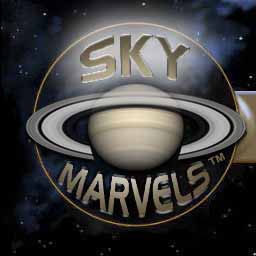








AVAILABLE MONTHS
2010:
Jan
Feb
Mar
Apr
May
Jun
Jul
Aug
Sep
Oct
Nov
Dec
2011:
Jan
Feb
Mar
Apr
May
Jun
APPARENT PATHS OF THE PLANETS
This month, some southern regions of Earth will be able to witness the Moon passing in front of Venus. Mercury starts the month in retrograde or "westward" motion in our sky, while three gas giants continue moving retrograde for the entire month.

MERCURY: 2010 Sep
Mercury kicks off the month in retrograde motion, passing the Sun in the middle of the first week. By month's end it is traveling eastward again and just enters Virgo (1.6.x) (1.4.1)
VENUS: 2010 Sep
Venus leads Mars eastward through Virgo, but "slows" as it prepares to go retrograde in Libra (1.6.x) (1.4.1). On the 11th, the Moon passes right in front of Venus! Known as an "occultation", this will be seen after sunset in parts of the southern Indian Ocean, and one of the better viewing locations should be on ILE AMSTERDAM (1.6.x) (1.4.1). The event will also be visible to the west, across southern Africa, the south Atlantic and to the extreme eastern edges of South America. However, in these three cases, this will be "before" sunset, therefore rendering it more difficult to observe. The following view "from Venus looking back at Earth" should help illustrate which parts of Earth are in daylight and darkness as the Moon moves between them (1.6.x) (1.4.1).
MARS: 2010 Sep
Very near the Ecliptic, Mars continues moving to the east for all of September, entering Libra by month's end (1.6.x) (1.4.1)
JUPITER, URANUS & NEPTUNE: 2010 Sep
Jupiter, Uranus and Neptune continue their retrograde motion in September. Jupiter and Uranus remain in Pisces, while Neptune remains in Capricornus (1.6.x) (1.4.1)
SATURN: 2010 Sep
In western Virgo, east-moving Saturn is not quite overtaken by the Sun at month's end (1.6.x) (1.4.1)
CELES-TIPS
The following will help you enjoy this page's many links that run events directly in CELESTIA. If you're new to the program, these tips will also help you learn to use it.
- If CELESTIA's clock (i.e. the program's date and time) is not visible at the top right of its window, press the V key until you see it. This will also turn on information text in other corners as well. This text will help you keep track of several aspects of the event you're viewing.
- Pressing the "un-shifted" L key and K key respectively will speed up and slow down CELESTIA's flow of time by a factor of 10 in version 1.6.x and 1.4.1.
- Pressing Shift+L and Shift+K respectively will speed up and slow down CELESTIA's flow of time by a factor of 2 in version 1.6.x only.
- Pressing the J key (either shifted or "un-shifted") will reverse CELESTIA's flow of time in version 1.6.x and 1.4.1.
You'll find more information about many of CELESTIA's controls on our Learning Center page.
Back to Top
Home Intro News Gallery Sky-Gifts Bonuses Tips
Learning Ctr Help Links Credits Legal Contact Us
© 2007-
by Gary M. Winter. All rights reserved.
Interested in political cartoons and humor?
Check out The HIPPLOMATS™.
SkyMarvels, SkyMarvels: Your Key to the Sky and the Universe! Sky Marvels, SkyMarvels.com, News, celestia4all, celestiaforall, CELESTIA, astronomy, space, simulations, animations, downloadable astronomy posters, stars, planets, Inner Planets, Outer Planets, Inferior Planets, Superior Planets, moons, asteroids, comets, Oort Cloud, galaxy, galaxies, Milky Way, Andromeda, globular clusters, binaries, quasars, black holes, supermassive black holes, telescope, telescopes, planetarium, software, freestuff, satellites, add-ons, addons, scripts, eclipses, Solar Eclipses, Lunar Eclipses, Solar Eclipse Finder, Lunar Eclipse Finder, mutual eclipses, transits, occultations, Solar System, CELES-TOOLS, celeSTARrium, CELX, CELX programming, Freebies, Bonuses, multiple views, atronomical unit, light year, parsec, meteors, meteor showers, Perseids, Geminids, Leonids, barycenter, time, Time Zones, tides, alignments, conjunctions, oppositions, seasons, apogees, perigees, aphelion, perihelion, Earth, Luna, Mercury, Venus, Mars, Jupiter, Galilean Moons, Io, Europa, Ganymede, Callisto, Saturn, Titan, rings, Uranus, Neptune, Triton, E-MSpectrum, electromagnetic spectrum, astronaut, equinoxes, solstices, precession, rotation, spin, inclination, tilt, Ecliptic, orbits, ellipse, parabola, hyperbola
HIGHLIGHT EVENT
MOON'S OCCULTATION OF VENUS 2010 Sep 11
To view this video in a larger size, click here.
THE SUN
APPARENT PATH OF THE SUN: 2010 Sep
Here are the Sun's positions along the Ecliptic at 00:00 UTC on the days shown. Autumn begins as the Sun sinks below the Celestial Equator on September 23.

The slightly curved lines above and below the Ecliptic show the extent of the Zodiac, which you may download from our Bonuses page and add to any version of CELESTIA. Note that the curve in the Zodiac lines is the result of CELESTIA's rendering in perspective.
 W A R N I N G ! It is never safe to look directly at the real Sun with the naked eye! Moreover, looking at it through a telescope or binoculars—even for an instant—can cause permanent blindness! NEVER DO IT! Consult the professionals at your local planetarium or observatory to learn how you can safely "observe" the Sun and any SOLAR eclipse!
W A R N I N G ! It is never safe to look directly at the real Sun with the naked eye! Moreover, looking at it through a telescope or binoculars—even for an instant—can cause permanent blindness! NEVER DO IT! Consult the professionals at your local planetarium or observatory to learn how you can safely "observe" the Sun and any SOLAR eclipse!
Of course, you can safely view CELESTIA's depiction of the Sun's apparent path in the sky in September. Here are the links: (1.6.x) (1.4.1). Note that versions 1.6.x and 1.4.1 differ in the way their "follow" and "lock" features work. If you "follow" Earth and then "lock" the Sun to it, versions 1.6.x and 1.4.1 respectively maintain the "attitudes" of the Ecliptic and the the Celestial Equator. This means that the Ecliptic remains "level" when you run the first link, but begins to tilt when you run the second! Differences like this will be discussed on our Help page.
HALF OF EARTH IN SUNLIGHT & DARKNESS
During your voyages in CELESTIA, would you like to be able to position yourself directly over the center of the half of Earth in sunlight or the half in darkness at any time this month? On our Tips page, you'll find that it's quite easy to do so! If you're any kind of sky watcher at all, you probably know just how helpful this can be!
THE MOON
PHASES OF THE MOON: 2010 Sep
In UTC per CELESTIA 1.6.x (& 1.4.1):
Last Qtr: Sep 1, 17:22 (17:23). New: Sep 8, 10:30 (10:31).
1st Qtr: Sep 15, 5:50 (5:51). Full: Sep 23, 9:17 (9:18).
NOTE: New, 1st Quarter, Full and Last Quarter Moons respectively are defined to occur when the Geocentric Ecliptic Longitudes of the Moon and the Sun differ by 0°, 90°, 180° and 270°.
To watch a short video demonstrating the Phases of the Moon, click here.

The above diagram is produced with our "Moon Phases Calendar" script. The numbers of the days of the month were added with an image-editing program.
To watch a short video of our Moon Phases Calendar in action, click here.
LUNAR APOGEE & PERIGEE: 2010 Sep
Per CELESTIA 1.6.x (and 1.4.1):
Perigee: Sep 8, 4:01 (4:02) UTC; 357,204 km.
Apogee: Sep 21, 7:54 (7:55) UTC; 406,174 km.
Determined by our "Earth-Moon Distance" and "Moon's Apparent Path" scripts. Note that distances given are the distances between Earth's and the Moon's centers.
LUNAR ANALEMMA: 2010 Sep
Here is the lunar analemma, generated by the Moon's positions relative to the mean lunar orbit and the Ecliptic at 0:00 UTC every day of September.

This phenomenon can be observed using our "Moon's Apparent Path" script. The analemma's change of shape month after month begins to give us an idea of just how irregular the lunar orbit is.
Donate safely with: PayPal
to receive one or more
Sky-Gifts. Your support is greatly appreciated!
Various astronomical "shadow events" occur throughout the Solar System! This month's more interesting ones are featured here.
SHADOW WORKS
Here we highlight the most awe-inspiring eclipses taking place in our Solar System. We also set them up so that all you need to do is click on their links. Don't forget that you can generate lists of Earth's, Jupiter's, Saturn's, Uranus's, Neptune's and even Pluto's eclipses, using CELESTIA's own built-in "Eclipse Finder." You'll find it in the program's menu under "Navigation".
All events listed below are displayed as if viewed from Earth, their magnifications shown in parentheses at the lower right of CELESTIA's window. Events involving more than one moon are often cyclical, so usually only the first example is given, and then the period of the cycle.
 JUPITER
JUPITER
While no simultaneous solar eclipses occur on Jupiter in September, its major moons do put on a good show. On many occasions, two or more Galileans can be seen near Jupiter. Here are highlights of the 30 solar eclipses that Io, Europa, Ganymede and Callisto produce this month. Jupiter's shadow stretches westward (to the right) until opposition with the Sun on September 21, when it starts stretching off to the east. Examples of some Galileans moving into it or emerging from it are included.
- Sep 2: Europa enters Jupiter's shadow; then Io does the same after Europa emerges from behind Jupiter in a cycle repeating about every 3½ days (1.6.x) (1.4.1)
- Sep 3: Io casts its shadow on Jupiter; Ganymede does the same hours later; and Europa does likewise hours later and passes Io in a cycle repeating about every 7 days (1.6.x) (1.4.1)
- Sep 6: Callisto moves through Jupiter's shadow, as it does about every 17 days (1.6.x) (1.4.1)
- Sep 7: Io completes casting its shadow before it passes Ganymede in a cycle repeating about every 7 days (1.6.x) (1.4.1)
- Sep 15: after Io and Europa repeat their Sep 3 cycle, Callisto casts its shadow far to the south on Jupiter (1.6.x) (1.4.1)
 SATURN
SATURN
While CELESTIA 1.6.x shows the shadows of Titan, Rhea, Iapetus, Dione and Tethys, version 1.4.1 displays only the shadows of Titan, Rhea & Iapetus. So, 1.6.x and 1.4.1 respectively show 34 and 7 solar eclipses on Saturn in September, 1.6.x revealing a few simultaneous solar eclipses. The highlights are as follows:
- Sep 1: Rhea casts its shadow deep in Saturn's southern hemisphere, as it currently does about every 4½ days; (1.6.x) (1.4.1)
- Sep 2: Tethys casts its shadow on Saturn, as it currently does about every 2 days; (1.6.x only)
- Sep 3: Dione casts its shadow on Saturn, as it currently does about every 2¾ days; (1.6.x only)
- Sep 5: Tethys, Dione and then Rhea cast their shadows on Saturn, but not simultaneously; Titan is visble but is too far "below" Saturn to cause an eclipse (1.6.x only)
- Sep 11: Dione and Tethys cast their shadows on Saturn simultaneously (1.6.x only)
- Sep 15: Tethys and Rhea cast their shadows on Saturn simultaneously (1.6.x only)
URANUS, NEPTUNE & Dwarf Planet PLUTO
Neither Uranus nor Neptune will experience eclipses for decades. Dwarf planet Pluto will experience no eclipses by Charon for about a century!












